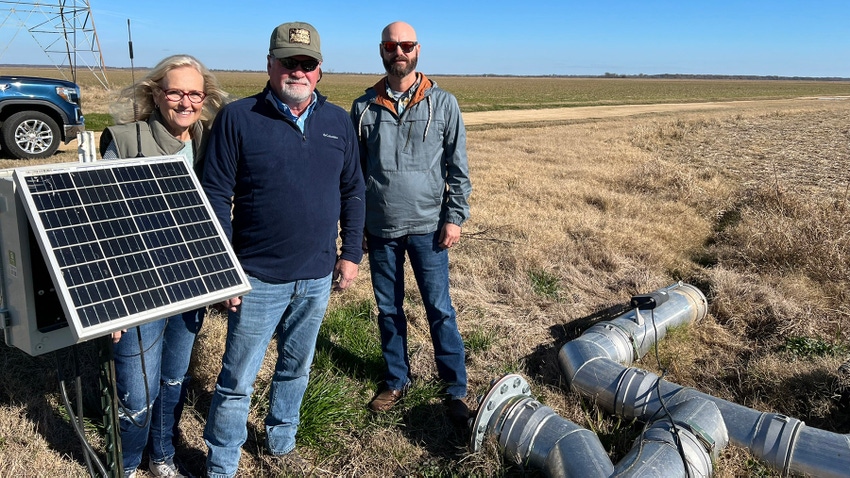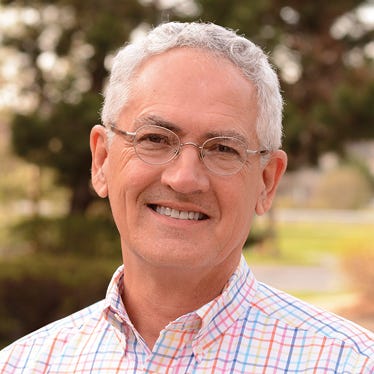
The first thing you see when you approach LTD Farms, south of Stuttgart, Ark., in mid-December may not be the precision leveled fields or the tail water recovery system or the grower’s commitment to sustainable farming, but what you will see are thousands of migratory geese taking advantage of abundant food and water on their way south for the winter.
As an indicator of a healthy biome, the geese flourish as they pass through an area where growers know the benefit of taking care of the land they hope to farm years into the future.
Taking the lead in initiating a process by which they can take care of the land in their charge are Lori and Terry Dabbs and their son Trent Dabbs, the Southern Cotton Ginners Association Ag Achievement Award winners for 2024.
The award celebrates collaboration between farmers and Universities to promote sustainability and on-farm innovation.
“Terry’s involvement with the university goes back to when he started farming,” Lori said.
“Thirty or 40 years, or longer,” Terry added.
Verification trials
It started with verification trials for the University of Arkansas – taking the university’s small field trials and putting them into full-scale, on-farm action to verify the results.
“We’d tell them what they were doing out there on a 10-by-10 plot may not work on an 80-acre field,” Terry said. “Let's get out here in the real world and test something. So, they started the verification program.”
With the help of the Arkansas Farm Bureau, with whom Terry is very active, the university later developed the Discovery Farm Program to develop environmental and agricultural sustainability for farming in Arkansas through a process of monitoring, demonstration, and research.
The program, through Best Management Practices with goals to reduce nutrient and sediment loss and conserve water, verifies nutrient and sediment loss reductions and water conservation. It helps mitigate nutrient and sediment losses, delivers outreach programs to producers for achieving production and environmental goals and provides information in support of development of the State Water Plan for Arkansas.
“The Dabbs family commitment to conservation is a perfect partnership with our Arkansas Discovery Farms program,” said Mike Hamilton, Irrigation Instructor for the University of Arkansas Division of Agriculture Cooperative Extension Service and the Natural Resourses Conservation Service. “They have embraced several innovative irrigation water management strategies and devices to improve irrigation efficiency on their farm.”
LTD Farms became one of the original four Discovery Farms sites during the first year of operation.
“It took two or three years to get organized and get funding,” Terry said. All those instruments we use are so expensive, so we had to raise money. Once we got it going that first year with four farms, then it wasn't long before others jumped in.”
Data collection
Some growers were skeptical about allowing the university to collect data on their farms regarding nutrient runoff or greenhouse gasses, according to Lori.
“Do you really want these people coming on your farm to find out this real information?” she said. “But we’ve always been Guinea pigs for them, and they knew they could count on us to jump in and support their efforts.”
The need for real data to provide to those who were not on the farm, but made decisions that would impact the farm, was vital.
“We were getting blamed for things that weren’t going on,” said Terry. “So, we needed some third-party data to go to the legislature and say, ‘Hey, we’re not doing what we are being blamed for.’”
They also wanted to make sure that they weren’t wasting resources. If nitrogen or phosphorus was getting flushed out of the field, they didn’t want to be washing money downstream. They have collected the data and helped quantify soil and nutrient loss.
But the most focused project on the Dabbs’ farm has been irrigation efficiency.
“Our big deal is water,” Terry said. “We’ve got to conserve water. So, we started looking at water irrigation practices.”
What’s available
The farm sits in an area where very little water is available from the aquifer – the last pumping was done sometime in the 1970s - so everything is irrigated by ground water. Little ground water is available to the farm from off-site sources, so they have to rely on what is available to them on the 2,000-acre farm.
Over-use or mismanagement of water on the farm can lead to a situation where no water would be available for the crop. When they took over management of the farm around 1998, they realized that capturing the water that flowed over the farm needed to be a priority.
The original water collection reservoir on LTD Farms where water is collected and reused for irrigation. (Brent Murphree)
Their first efforts at conservation were with land leveling – trying to get the efficiency level up by regulating the flow, use and return of water for irrigation on their land.
Initially an existing reservoir was used to catch tailwater. Several more reservoirs have been built with help from the NRCS and the local irrigation district. Tailwater ditches were built as well.
In the past few years Trent has taken advantage of moisture sensors and irrigation scheduling.
What they’re doing is not necessarily creating a new process. They use Delta Plastic’s Pipe Planner to plan delivery from the water source.
“It takes into account the length of each furrow, the number of furrows that each set of polypipe is going to be irrigating, and then the volume of water,” Hamilton said. “And it tells you what size holes to punch so that each of those furrows will get out at the same time.”
Pipe Planner is available through Delta Plastics website.
They are also using soil sensors to identify where water is needed throughout the crop. The probes measure moisture at 6 inches, 12 inches, 18 inches and 30 inches down into the soil profile so that the levels can be evaluated at different depths.
Plant water use
The sensors also identify where the plant is using water and where it is not using the water. This is especially helpful after a rain, when the crop may not need to be watered, thus saving the time and energy to get water to the crop. It also indicates just how much water is being used at particular points in the plant’s development.
With funding from the Nature Conservancy, the Dabbs - with Hamilton’s help - are working to determine a surge flow rate that will optimize irrigation and mitigate compaction in their precision leveled fields.
The Dabbs have done extensive land leveling on their farm to recover water used for irrigation on their rice, soybean and corn acres. (Brent Murphree)
The automated surge pattern would eliminate unnecessary irrigation in areas where the crop does not need more water.
“It's all tied into this and doing more automation,” Trent Said. “Just trying to figure out ways to increase efficiency and better use of water.”Together, the Dabbs and the University of Arkansas are working to make irrigation efficiency a regular part of growing crops in the Delta.
About the Author(s)
You May Also Like






